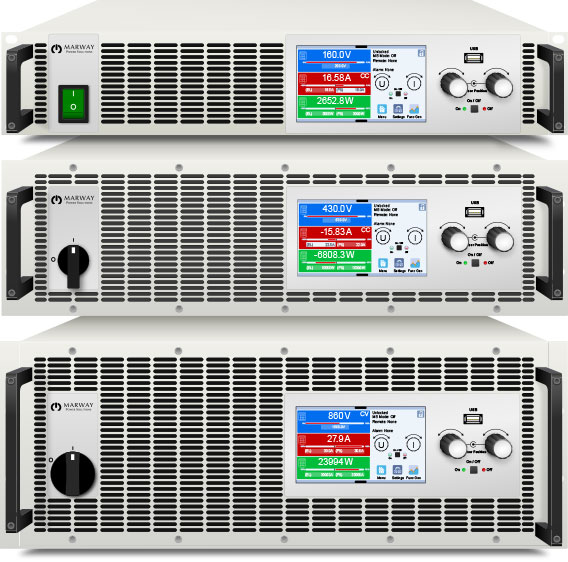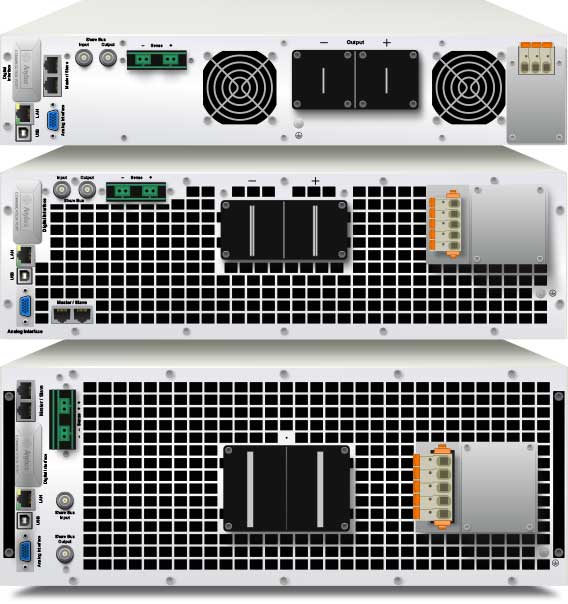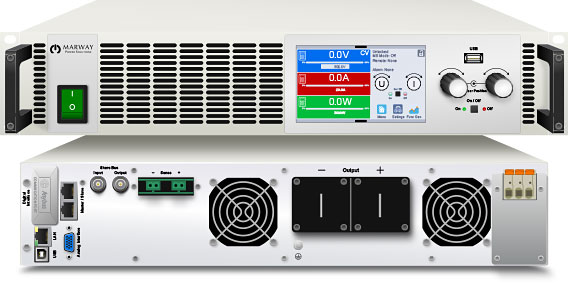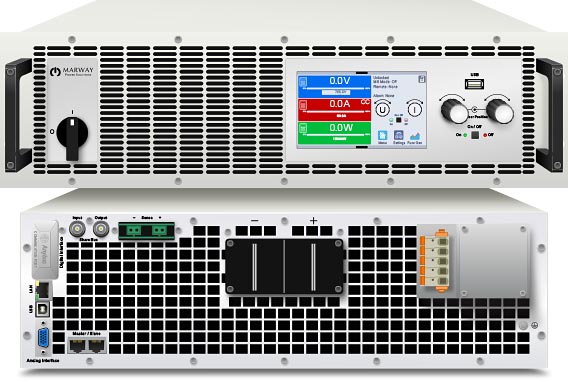mPower™ DC 411 Bidirectional Power Supplies
mPower DC Bidirectional
Programmable Power Supply ↑
Marway’s lab quality mPower DC power supply includes many advanced capabilities usually found only in systems costing much more. A cornerstone feature is the autoranging dc signal (both output and input modes). The benefit of autoranging allows a single modestly-powered supply to cover test cases of higher voltage or current compared to conventional power supplies. Autoranging saves capital costs and rack space, and even simplifies test setup. (Learn more about autoranging.)
As a programmable power supply and load, mPower offers Modbus and SCPI command protocols which can be sent directly through USB or Ethernet, or wrapped in variety of higher level field bus protocols such as Profibus, ProfiNet, EtherCAT, variations of CAN, and others.
With dozens of models, mPower provides solutions for low and high voltage power supply needs, low and high current power supply needs, and the ability to “stack” or parallel multiple units together to achieve high power capacities as well.
mPower 411 has the ability to automatically toggle between power supply and electronic load operation. This double-duty capability saves even more space and capital costs for test stations traditionally outfitted with hardware for both supplies and loads.
Powerful capabilities
- Source and sink of the full power capacity.
- Sink functionality comes from transferring energy back to the grid with up to 96% efficiency.
- Available in 1.5 and 3.0 kW (2U), 5, 10, and 15 kW (3U) and 30 kW (4U) totalling almost 50 models.
- Up to 64 parallel units. With the 30 kW models, it’s possible to power up to 1,920 total kW with each unit having up to 2,000 Vdc or up to 1,000 amps.
- Programmable dc signal using ModBus and SCPI protocols on a variety of interfaces.
- Operate in constant voltage, current, power, or resistance mode.
- Autoranging dc output delivers full power for a wider range of voltage and current settings.
- Active power factor correction of input power.
- Function generator to automate profiles for the dc output voltage or current.
- Data logging to USB drive.
- Remotely controllable through Windows®, LabView®, and your own custom scripts.
- Sense bus to measure and adjust dc output at the load to ensure the DUT gets the precise voltage the test calls for.
- Safety features including user interface lockout and quick discharge circuitry. Built-in alerts for over voltage, current, power, and temperature.


Function Generator ↑
- Works for either source (supply) or sink (load) operation.
- Multiple standard wave forms.
- Arbitrary wave forms with up to 99 steps.
- XY-Table functions with USB import/export.
- Programmable on screen, or using ModBus or SCPI commands.
A common need for a programmable dc power supply is to deliver the output voltage or current with a pattern other than a straight-line dc signal. The built-in function generator of the 411 Series is able to create various signal forms and apply these to the set value of the dc output voltage or current. The function generator includes options for sine, triangle, rectangle, and trapezoid waveforms, as well as custom arbitrary wave forms. Additionally there are configuration tools for ramping and UI tables. Table configuration data can be exported to and imported from a USB port on the front of the system.
The function generator can be configured on screen with menu- and form-driven options. It can also be programmed using ModBus or SCPI commands, or driven using LabView VIs.

Renewable Energy Simulations ↑
- Photovoltaic power simulations.
- MPP Tracking controls.
- Fuel cell power simulations.
- Battery charge and discharge tests.
With the rapid time to market demands in renewable energy systems, having the ability to simulate key power sources, loads, and controls can save time during development and manufacturing testing. mPower has the ability to simulate PV power sources using either a simple or extended model simulation, and the abililty to substitute for solar inverters. The bidirectional capabilities and built-in test logic enable mPower 411 to stand in for fuel cells or batteries, or their loads as well.
Built in configuration tools simplify simulations to entering a few parameters via GUI touch panel (or remote programming). The power supply software then automates the sequence of the power source or sink profile.

Programming and Remote Control ↑
The advantage of a programmable power supply is the ability to automate test sequences during device development or production. The programmable part is the ability to set the voltage, current, power, and other settings with a script or program on a remote computer. As the product being tested is powered, the power levels can be changed to follow specialized patterns, known as waveforms or profiles, and switched on and off automatically to verify the product‘s functionality with different power inputs.
- Remote control is available through a Windows® program, LabView®, or through custom scripting.
- Scripting is done using ModBus and/or SCPI protocols.
- 411 Series features USB, Ethernet, AnyBus, and analog remote control (AnyBus enables RS-232, Ethernet, ModBus TCP, EtherCAT, CAN, OpenCAN, Profibus, and ProfiNET).
Individual units can be controlled over any of the available interfaces. For manual control of a nearby, but difficult to reach unit, a Windows application can be used over USB.
Alternatively, once a unit is configured to run with specific parameters, remote control is possible through an analog interface which gives dc output control, alarm notification, and the ability to monitor a few key values.

Multi-unit Parallel Setups ↑
- Increase the total current and power with parallel units.
- 411 Series can run up to 64 units in parallel.
- All models can be used in a “control” or “expansion” role.
For large power needs, whether permanent or temporary, it can be useful (and cost effective) to combine smaller units in parallel rather than acquiring a large dc power supply to cover those cases.
For managing multiple parallel-wired systems, there are two buses in use. All series have the Share bus. This helps multiple units communicate power status for balancing the dc output. The 411 series also have a logic bus which further adds the ability for a control unit to adjust setpoints, control dc output switching, monitor alarms, and manage other data across all units.
Running systems in parallel requires that each unit is from the same series. With the 411 Series, each unit can be a different model (though it is safest to use the same voltage ratings).

Available Models ↑
The 411 Series provides a wide range of power options with an advanced control system, function generator, and menu-driven touchscreen operation. Offering 1.5 kW to 30 kW, up to 2000 Vdc, and up to 1000 Amps, the 411 series can be either a high voltage power supply, or a high current power supply. Thanks to the autoranging power core, for many applications it can be both!
- 1.5 kW • 411 Series 2U
Six models from 60 Vdc/60 A to 750 Vdc/6 A. - 3 kW • 411 Series 2U
Eight models from 60 Vdc/120 A to 1500 Vdc/6 A. - 5 kW • 411 Series 3U
Six models from 60 Vdc/170 A to 750 Vdc/20 A. - 10 kW • 411 Series 3U
Eight models from 60 Vdc/340 A to 1500 Vdc/20 A. - 15 kW • 411 Series 3U
Nine models from 60 Vdc/510 A to 2000 Vdc/20 A. - 30 kW • 411 Series 4U
Ten models from 60 Vdc/1000 A to 2000 Vdc/40 A.

